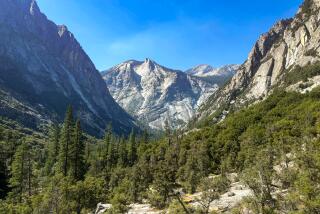Aircraft Aren’t Stealing Grand Canyon’s Solitude
- Share via
I flew with my brother over the Grand Canyon last spring. He piloted the helicopter past a large butte known as Mencius Temple, then nodded, smiling, at the tangled white and green waters of Crystal Rapids far below. At this same point, on a clear morning in June, John died in a violent mid-air collision.
The first news accounts reported no survivors among the 25 passengers and crew members. I wasn’t worried. I knew that my brother wouldn’t be involved. He not only had flown thousands of hours in the canyon, he also was obsessed with safety. Too many close calls in Vietnam had taught him not to take chances; a wife and two kids at home kept him from forgetting that lesson.
After an aerial view of the wreckage flashed onto the television screen, the report cut to the controversy concerning air-traffic noise in the Grand Canyon. “This is a tragedy, of course,” an environmentalist said, “but it just goes to show you there are too many aircraft there.” The phone rang, and I heard from a friend that my brother was dead.
No matter how unexpected, no matter how senseless, an accident is never entirely accidental. One factor that contributed to the accident is especially troubling. Both aircraft were flying modified air routes. They would not have been where the collision occurred if it had not been for the constant pressure from environmentalists to curtail canyon flights. For more than a year the air-tour operators have been altering their safe, customary routes to avoid being saddled with National Park Service regulations that threaten to put them out of business.
The park service has been under the gun from groups such as the Wilderness Society and Sierra Club, demanding an end to all flights into the Grand Canyon. Emotions are running high. Last year a group of ecology buffs threw rocks at my brother’s helicopter as he flew past some Indian ruins.
The core of the environmentalists’ claim is that the solitude of the wilderness is being violated by aircraft. It’s a hollow claim. I have hiked hundreds of miles there--alone. I have lived in the canyon for months at a time, worked as a park ranger and trail guide, and made 56 trips on the Colorado River. I know where to go and where not to go to find solitude, and there is plenty to be found in the area--if one knows where to look.
Those who know the canyon realize that if you want a wilderness experience there are certain places that you have to avoid: Stay out of the Phantom Ranch corridor and its congestion of hikers and mules; avoid the scenic attractions near the river such as Elves Chasm, the mouth of Havasu Creek, Deer Creek Falls, Thunder River--they are overrun by river runners. Avoid the points where air tours fly in and out of the canyon. The rest is yours. If you plan it right, you can walk for days without seeing another soul.
What people forget is the immensity of the canyon. It stretches almost 280 miles, is a mile deep, averages nine miles wide with a width of 25 miles in some places. There are only 50,000 flights a year--private, military and commercial--over an area twice the size of Rhode Island. I once stood on the canyon rim as a Frenchman tried to make sense out of the scene before him. “It is unbelievable,” he said as he threw out his arms. “What we see is only a small part. The Grand Canyon is a third the size of France--just think of it!”
The “sound wars” controversy has been distorted beyond logic. About 2.5 million people visit the Grand Canyon each year, yet in 1984 (the last year for which records are available) just 17 people complained to the park service about aircraft noise. The park service, pressured by environmentalists who have not hesitated to use the recent air-crash deaths to further their cause, is on the verge of imposing radical restrictions on air flights over the canyon.
You find what you look for at the Grand Canyon. Those who look for noise hear it; those who look for solitude discover it. My brother walked from one end of the canyon to the other, rafted down the river, lived for years just south of its rim. For him it was a home, not just a political issue that will be forgotten as soon as the next crisis materializes.
More to Read
Sign up for Essential California
The most important California stories and recommendations in your inbox every morning.
You may occasionally receive promotional content from the Los Angeles Times.










